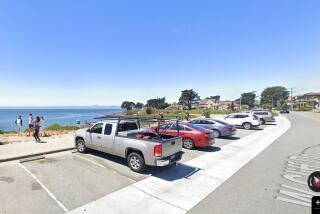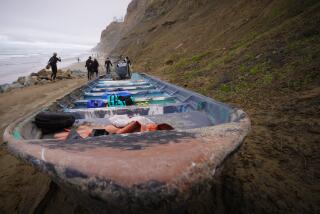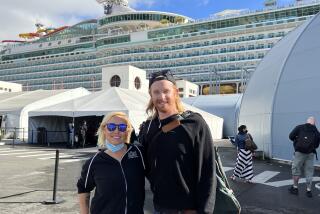Volcano’s Eruption Shook Up Vacation of Southland Sisters
- Share via
Two Southern California sisters were among 150 vacationers caught in a sudden volcanic eruption in Nicaragua, and one of them suffered a broken arm, according to accounts provided Wednesday by the sisters and the Holland America line.
At least half of the tourists who experienced the April 23 eruption, some suffering cuts and bruises, were reported to be from California. They were on a one-day land tour off the cruise ship Veendam, which was docked at San Juan del Sur, Nicaragua.
The eruption of the Masaya volcano, which has had 44 eruptions, mostly minor, since 1970, occurred at a moment when passengers of the ship were at the lip of the crater. Their tour buses were hit by rocks ejected during the eruption.
Injured was Stephanie Mason, 29, of Redondo Beach, who stumbled, sprained her ankle and fell on her right arm, breaking it, as she tried to get away from a burst of smoke and volcanic ash that threatened to envelop an observation point.
A spokeswoman for Holland America said the line flew a crisis counselor to the ship to comfort the passengers and 28 crew members, who were also at the volcano.
“We were certainly very relieved there weren’t many serious injuries,” said Julie Patton of Holland America. “Most were in the neighborhood of cuts and bruises. A lot of people were shaken up. Ms. Mason was the most seriously injured.”
Mason, who must wear a cast for six weeks, paid tribute Wednesday to the ship’s doctor, identified by the company as Sidney Schneidman, of Philadelphia, for “wonderful care.”
She said he X-rayed her arm, took digital photos of the X-rays and e-mailed them to an orthopedic specialist in Texas, who sent him back precise instructions on treatment.
Mason said a Nicaraguan tour director she could identify only as “Jimmy” put himself in danger to ensure everyone was safe.
“After the wind shifted and the smoke blew the other way, he actually ran to the top of the hill where many of us had been hiking to be sure no one had been left behind,” she said.
Pictures displayed Wednesday by Mason showed that the parking lot itself is literally on the lip of the 2,083-foot volcano, just 13 miles from the Nicaraguan capital of Managua.
“When we first arrived, there was sulfur coming out, not a lot, and they said that was normal,” Mason said. “The buses pulled to within 10 to 15 feet of the actual crater.
“There’s a little lookout point even closer. We went to the lookout point and then up a stairway to a further lookout point with a big cross at the top of a hill.
“Almost everyone had walked up to the cross, when suddenly there was a really big noise and a huge cloud that filled the crater and started moving higher.
“The first thing that went through my head was, this looked really cool. Then, I realized it wasn’t cool. Everyone started running down the back side of the hill, because we were worried about the smoke and the potential for lava.
“A lot of people fell and had scrapes on their legs. . . . I fell right on a rock. It was a very steep hill.”
Meanwhile, rocks were falling on the parking lot, where Mason’s sister, Danielle Criona, 31, of Santa Monica, was resting in a tour bus.
“I heard a loud rumbling,” Criona said Wednesday. “Before I could even process what it was, a rock, probably about a foot long, came crashing through the roof of the bus and landed in the next seat behind me.
“Then the bus driver came running. The bus was being hit by a shower of smaller rocks, I could hear them on the roof, and he starting driving the bus forward.
“I started screaming, ‘You can’t leave. My sister is up that hill.’ But he was already stopping as we got clear.”
The scariest thing, Criona said, “was we had no concept of how big the eruption was going to be.”
The U.S. Smithsonian National Museum describes Masaya as one of Nicaragua’s most active volcanoes, with an occasional lava lake and many overflows of lava. A fourth crater was formed earlier this year.
The April 23 eruption sent rocks with diameters of up to 20 inches flying as far as 600 yards. The official report said a number of vehicles were damaged and, “in the later phases of the explosion, small quantities of lava and ash were released.”
More to Read
Sign up for Essential California
The most important California stories and recommendations in your inbox every morning.
You may occasionally receive promotional content from the Los Angeles Times.













